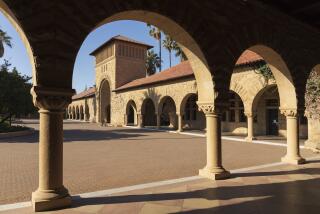One Who Took the High Road
- Share via
PALO ALTO — All last week across Silicon Valley, within the uniformly low-slung, well-manicured cathedrals of high technology, over the cloth partitions of workstations and the ethereal pathways of computer networks, high priests and acolytes of cybernetics alike were telling what they called “Dave stories.”
“Well, my Dave story . . .,” a Hewlett-Packard vice president typically would begin, winding up for yet another anecdotal eulogy to David Packard, co-founder of Hewlett-Packard--the pioneer company that planted the first flag for high tech on the San Francisco Peninsula.
They told how Packard--”Dave,” they all called him--once stuck around after a company seminar to help break down folding chairs and pack them off to the basement. “That’s so Dave,” they would say, shaking their heads.
They told how Packard, practitioner of what he called “management by walking around,” once became irritated with the numerous meetings and conferences his underlings kept calling. He went out and locked up every conference room. Thus ended the meeting explosion.
They told how Packard, a child of the Great Depression, campaigned late in his career to maintain a “pay as you go” philosophy at the company. He distrusted borrowed money. He distrusted government contracts, with their built-in volatility. He distrusted anything that smelled of short-term. He was, they said of Packard, in it “for the long haul.”
*
For Packard the long haul ended last Tuesday. He died at the age of 83, surrounded by family and also--how strange this must have seemed to him--by intensive care machinery made by Hewlett-Packard. Here in Silicon Valley, word of his death stirred extraordinary expressions of loss. The wealthy are almost always buried well, but this outpouring transcended the common supplications.
Everybody had a Dave story, and all made the same point: David Packard did not behave like a billionaire CEO is supposed to behave. He treated employees like something other than ballast, to be chucked overboard whenever stock loses altitude. He was a pioneer of company health care and flexible hours and the notion of corporate responsibility. Personally, he donated vast sums to charity, building hospitals, schools, passing out grants.
“The more I hear about him, the more I respect him,” said a young man interviewed while planting ivy late Friday afternoon alongside a two-story bungalow near downtown Palo Alto. “So many people in his position just surround themselves with their wealth, use it to shut everything else out.”
The bungalow--not coincidentally--was located at 367 Addison Ave. This is a seminal address in the Horatio Alger story of David Packard and Bill Hewlett. In 1938 they converted into a workshop the tiny car barn that still stands behind the house, investing $538 to assemble a gadget called the audio oscillator. The rest, as they say in such stories, is history.
*
The man planting ivy, named Smitty, said Hewlett-Packard sales reps drive by almost daily with clients, “to genuflect and pay homage.” Smitty rents the bungalow’s top unit. He said the bottom floor, which was where Packard and his wife lived when the company was started, is now occupied by “some young guy, a computer graphic design wizard.” And here Smitty shrugged. These young computer wizards are a common breed around here--tapping away into the night, hunting the big idea. They are part of Packard’s legacy.
Another is a management style known as “the H-P Way.” It eschewed many corporate conventions, knocking down walls between management and employees. Packard and Hewlett were out to make money, without apologies. Yet it was their belief that the path to profit began with energized, loyal employees, who in turn would create quality products that satisfied customers. And if the blue shirts of Wall Street bought in, well, so much the better.
That it seems so simple raises a question: How come the stampede of American CEOs now thunders in an opposite direction? Downsizing to jack up stock. “Outsourcing” to reduce payroll. Snickering at the very notion of employee loyalty, a sentiment as outdated as buggy whips. Packard understood he was out of step. He himself told a Dave story, reprinted this week:
Decades ago, he recalled, he attended a business conference. The topic was corporate responsibility, and the general consensus was that the first and only duty was to shareholders. “I said, ‘I think you’re absolutely wrong. Management has a responsibility to its employees. It has a responsibility to its customers. It has a responsibility to the community at large.’ And they almost laughed me out of the room.”
Last year, Hewlett-Packard did $31.5 billion in business. Ho, ho.
More to Read
Inside the business of entertainment
The Wide Shot brings you news, analysis and insights on everything from streaming wars to production — and what it all means for the future.
You may occasionally receive promotional content from the Los Angeles Times.










